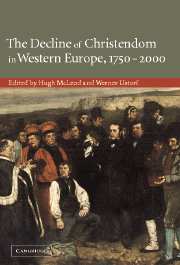Book contents
- Frontmatter
- Contents
- List of contributors
- Preface
- 1 Introduction
- Part I
- Part II
- 5 Established churches and the growth of religious pluralism: a case study of christianisation and secularisation in England since 1700
- 6 Catholicism in Ireland
- 7 Long-term religious developments in the Netherlands, c. 1750–2000
- 8 The potency of ‘Christendom’: the example of the Darmstädter Wort (1947)
- Part III
- Part IV
- Index of people and places
- Subject index
5 - Established churches and the growth of religious pluralism: a case study of christianisation and secularisation in England since 1700
Published online by Cambridge University Press: 03 July 2009
- Frontmatter
- Contents
- List of contributors
- Preface
- 1 Introduction
- Part I
- Part II
- 5 Established churches and the growth of religious pluralism: a case study of christianisation and secularisation in England since 1700
- 6 Catholicism in Ireland
- 7 Long-term religious developments in the Netherlands, c. 1750–2000
- 8 The potency of ‘Christendom’: the example of the Darmstädter Wort (1947)
- Part III
- Part IV
- Index of people and places
- Subject index
Summary
Secularisation theories have largely been abandoned by most of their erstwhile inventors as being inapplicable to most parts of the world except western Europe. Indeed all kinds of theories of historical inevitability have taken a fearful pounding in the half-century since the publication of Sir Isaiah Berlin's famous lecture on the subject at the London School of Economics in 1953. History without contingencies is like life without choice, but contingencies require explanatory frameworks. The purpose of this chapter is to advance an argument about the process of religious change in England from around 1700 which takes account of contingencies, but which seeks to establish analytical structures of more general application. The argument is that in England the rise of a more pluralistic religious society in the nineteenth century led to an increase in the social significance of religion (however that is to be measured) in the short run, but that the distinctive way in which it happened posed more serious problems for churches in the twentieth century. Ironically, the rise of a more voluntaristic and competitive religious environment in England helped erode some of the conditions that had nurtured its own development. What follows, therefore, is a tentative explanation of that story in England which is markedly different from the religious trajectories of other countries in the same period, including, for the sake of comparison, Ireland and the United States.
- Type
- Chapter
- Information
- The Decline of Christendom in Western Europe, 1750–2000 , pp. 81 - 98Publisher: Cambridge University PressPrint publication year: 2003
- 2
- Cited by



